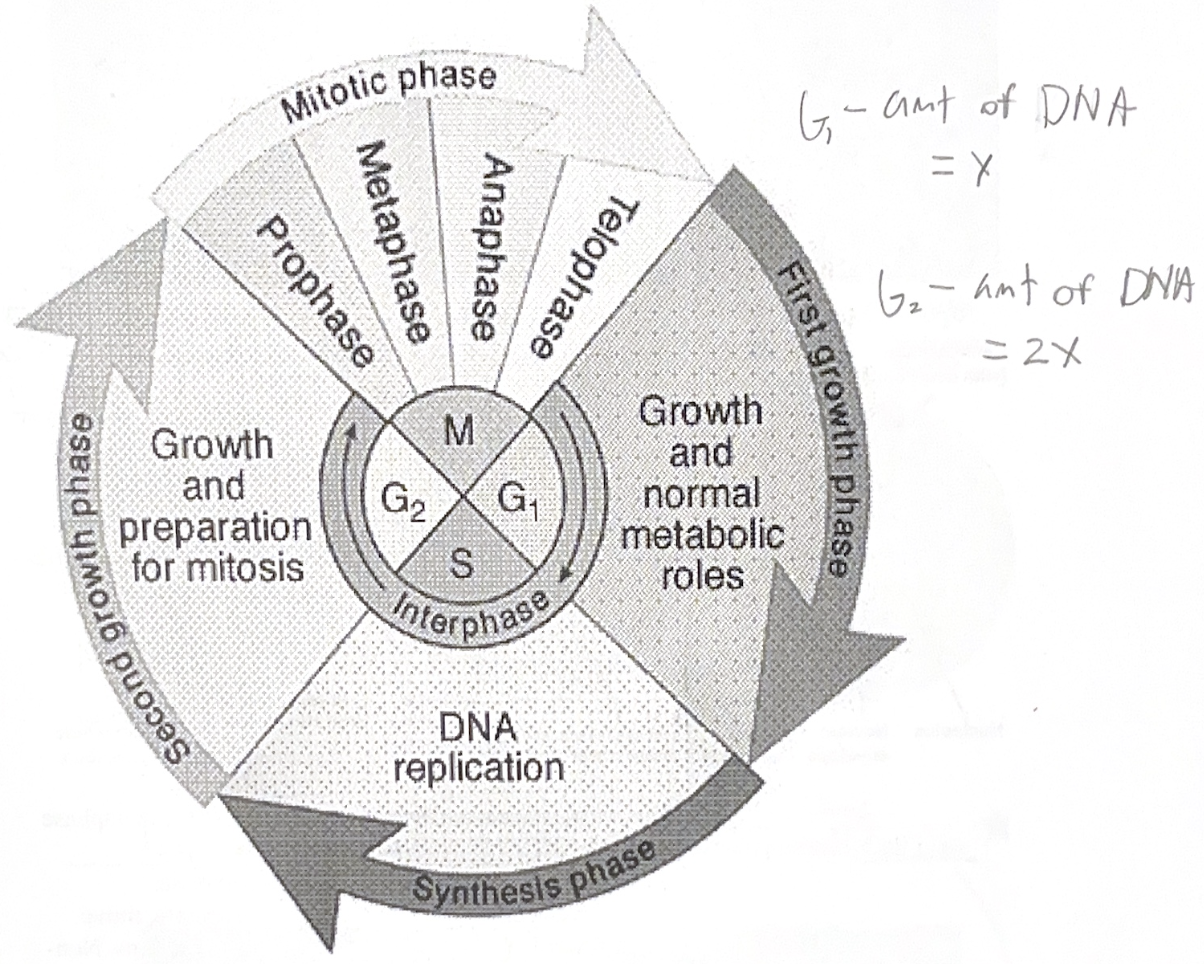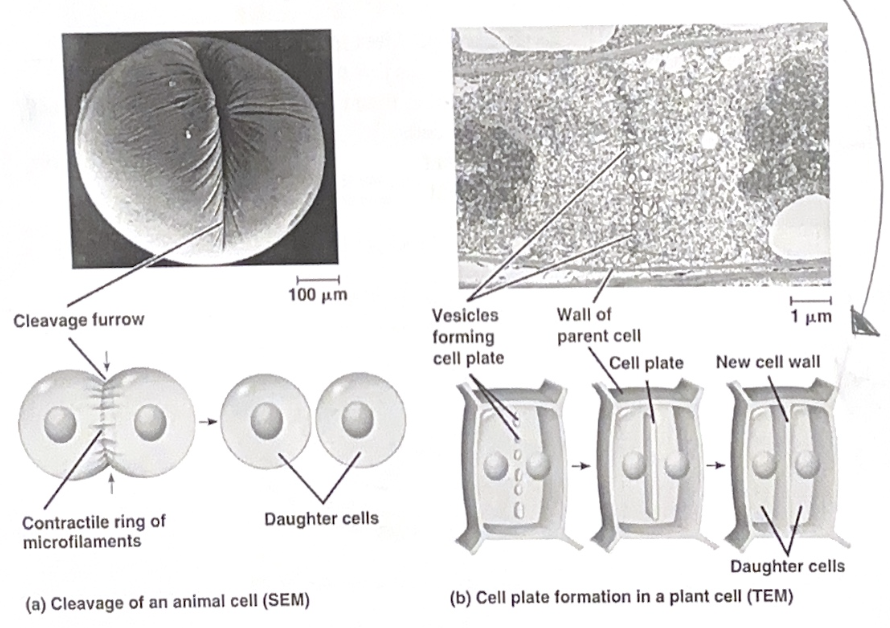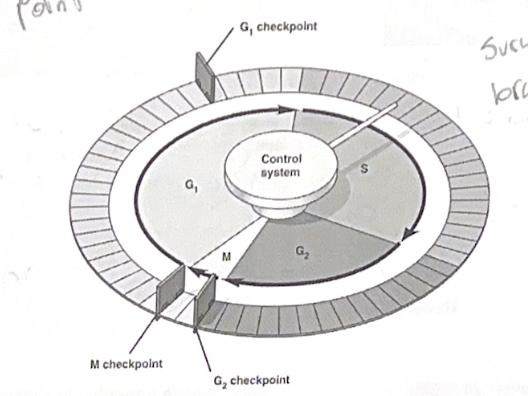AP Bio ch 12, 13
Chapter 12
Cell Cycle
Mitosis - Somatic cells (body cells)
Meiosis - Gamates - egg/sperm
- From the time the cell is formed until its own division into daughter cells.
- The genetic material (DNA) divides (duplicates) first, then the rest of the cell
- The DNA composes the genome
- Prok’s - Single DNA loop
- Euk’s - Multiple strands
- DNA compacts into chromosomes
- Every Euk species has a certain number of chromosomes
- Humans - 2 pairs of 23 (one pair from each parent) = 46 (in somatic cells)
- Gamates - 23 total
- Composed of chromatin - compacted DNA and proteins
- Sister chromatids are connected at the centromere

Overview of cycle -
Interphase - Longest (90% of the cycle). Growth and copying of information
- G1 - First gap phase - growth of cell
- S - Synthesis - Chromosomes replication
- G2 - Second gap phase - grows more
- Mitosis and cytokineses (Splitting of the cytoplasm) compose the shortest period of the cycle
- Mitosis means duplication of the nucleus
- M phase - Mitosis (outline)
- Prophase
- Prometaphase
- Metaphase
- Anaphase
- Telophase
PPMAT

- What happens - in depth
- Prophase: Formation of the mitotic spindle from the centrosomes (microtubule organizing center).
Radial array of microtubules around the centrosomes = an aster. Chromatin condenses.
- Prometaphase: Spindle microtubules attach to kinetochores (proteins at centromere).
Nuclear envelope diminishes. Tug of war between poles.

- Metaphase: Chromosomes settle at the metaphase plate (middle). Longest stage of mitosis. Spindle is now complete.
- Anaphase: Chromatids separate, move toward poles by motor proteins. Non-kenetichore microtubules elongate the cell. Shortest stage
- Telophase: Nuclei reforms.
Chromosomes begin to unwind. MITOSIS is now complete.

- Cytokenesis - occurs by a process called cleavage.
Cleavage furrow forms first in animals. Cell plate forms in plants.

Binary Fission - Division (separating) in half (found with bacteria). Usually a single chromosome in a ring. DNA starts replicating at origin of replication, cells elongates, membrane stretches then separates to two sides, cells split into two halves.

Regulation of the cell cycle
- Some cells split often (skin) while others rarely split (nerve)
- Molecular signals drive the cell cycle
- These molecules composed the “cell cycle control system”
- Checkpoints - Certain conditions are “looked” for by molecules
- G1 checkpoint - Most important - “Restriction point”. If it passes this checkpoint then cell cycle completes. If not, then cell remains in a G0 stage (most non-dividing cells)
- G2 checkpoint
- M checkpoint


C - Cyclin
D - Dependent
K - Kinases
- Molecules that drive this system
1. Kinases - enzymes, constant concentrations in cell
2. Cyclin - total amount cycles/fluctuates in the cell
- How these molecules work to drive the cycle
- Kinases must be attached to cyclin to work so these are called “cyclic dependant kinases (CDKs)”. These complexes of kinase and cyclin are called “maturation promoting factors (MPFs)”.
These MPF’s trigger the cell to pass the G2 phase and enter the M phase.
- In Example - Attachment of the spindle fibers at the kinetochores.
Kinetochores keep sending molecular signals to keep building fibers until all kinetochores are attached
- Scientists are trying to figure out what all the MPF’s actually do in the cell

Growth Factors - Proteins released by cells that promote mitosis
- In Example - Platelet derived growth factors (PDGF) - many are produced when there is an injury to the body in order for the tissue to promote mitosis
Density Dependent Inhibition - Crowded cells stop dividing because of lack of nutrients

Anchorage Dependent - Most cells require an anchor or base to attach to
Cancer - Cancer cells do NOT pay attention to the above cues.
- They might make their own factors?
- Abnormal cell cycle control system?
- “Immortal” cells. They keep dividing. “HeLa” cancer cell line has been dividing continuously for almost 60 years
- Transformation - Normal cells change to cancerous (usually body will kill these cells after transformation, but not always = cancer)
- Benign tumor - stays in same location
- Malignant - Invades local organs
- Metastasis - Spreads to different locations in the body
Chapter 13
- Transmission of traits from one generation to another - inheritance, or heredity
- With inheritance there are both similarities and differences
- Genetics is the study of heredity and variation
- Parents endow their offspring with genes - heredity “units” of DNA
- Tens of thousands passed on to offspring
- All the genes compose the genome

- Gametes - the cells used by plants and animals to pass on their genetic info
- All genes can be found at a specific, corresponding location - Locus

- Asexual reproduction - A single individual is a parent and passes on ALL of its genetic information by mitosis to a clone. Can be single or multicellular organism.
- Variation in family lines is caused by mutations.

- Sexual reproduction - variation is caused by both parents passing on a set of their genetic information that then combines.
- Meiosis - the production of gamates (egg/sperm) that might be used in sexual reproduction
- Karyotyping - matching up pairs of chromosomes from longest to shortest
- These pairs are called homologous chromosomes or pairs of autosomes

- There are also two distinct chromosomes that might not match - sex chromosomes
- Males - XY - smaller amount of DNA
- Sperm can either be X or Y
- Female - XX
- Egg is always X
- Haploid cell (n) - single set of chromosomes (in humans, n=23). Offspring recieves one set from maternal (egg) side, another from paternal (sperm)
- Diploid cell (2n) - BOTH sets of chromosomes (in humans, 2n=46)

- Life cycle begins when egg meets sperm and is fertilized (forms the zygote)
- Zygote is a diploid
- The only cells not produced by mitosis are the gametes
- Meiosis - reduces the number of chromosomes sets from diploid to haploid
- Two consecutive cell divisions, meiosis I and meiosis II
- 4 daughter cells produced
- Interphase - replication of genome and growth occur. Centrosomes replicate
- Meiosis stage
- Prophase I - 90% of total time of meiosis
- Chromosomes begin to condense
- Homologous chromosomes pair and match up by gene (forming a tetrad)
- Crossing over - where ever these homologous chromosomes match up, genetic information will switch to opposite chromosome
- Centrosome movement toward poles of cell
- Spindle formation and attachment of fibers
- Breakdown of nuclear envelope

- Metaphase I - tetrads arrange on the metaphase plate, spingle is fully attached
- Anaphase I - sister chromatids move toward poles
- Sister chromatids remain attached
- Telophase I and Cytokenesis I
- Each cell will have sister chromatids
- Splitting and cytokenesis
- Chromosomes might unwind, might not (depending on organism)

- Prophase II - spindle apparatus forms, movement of sisters towards metaphase plate
- Metaphase II - Spindle fibers attach to sisters at metaphase plate
- Anaphase II - Separation and migration of individual chromosomes toward poles
- Telophase II and Cytokenesis II - Nuclei form and chromosomes unwind
What makes meiosis unique?
1) Synapses - process of attachment of homologous chromosomes
- Crossing over - genetic rearrangement
- Chiasma (plural - chiasmata) - physical manifestation of crossing over

2) Tetrads on metaphase plate
3) Separation of homologous chromosomes in Anaphase I, but sisters stay attached to each other

- Three mechanisms that contribute to genetic variation
1) Independent assortment of chromosomes - random orientation of homologous pairs at metaphase I
- 50% of the homologous pair is maternal, 50% is paternal

- Which way is it going to be facing when “pulled by the spindle?
- Law of independent assortment basically says “every chromosome for itself”
2) Crossing over - produces recombinant chromosomes (from multiple origins)
- DNA is switched between maternal and paternal chromosomes
- In humans there are roughly 1-3 crossing over events per chromosome

3) Random fertilization - the chance that you are sitting here are staggering.
- Paternal side 2²³, maternal side 2²³ and we then multiple = about 70 trillion : 1 (and this does NOT take into account crossing over events)